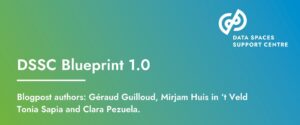This content was created by the Data Sharing Coalition, one of the founding partners of the CoE-DSC.
Self-sovereign identity (SSI) is an emerging model for managing digital identities by means of providing individuals ownership and control over their data. Originating from The Seven Laws of Identity by Kim Cameron in 2005, in its current form it came around in the last decade. However, according to Fraser Edwards, co-founder and CEO of cheqd, it has not been widely adopted yet. He explains why this is the case, why broad adoption is important and he gives examples of use cases.
Accelerating the adoption of SSI
Fraser believes the scarce adoption is mainly due to the lack of a commercial model for SSI, which means there are no options to monetise data. Fraser: “The majority of SSI projects are being driven by governments, but private enterprises are profit driven and have held off because they haven’t seen a commercial model yet. So we built cheqd, a blockchain network that individuals and organisations can use to build their use cases on and take full control of their data. We offer payment rails for SSI, which is our key differentiator. These enable a receiver of data to pay the issuer. This makes it easier to engage private enterprises. We believe that, by providing this commercial model, we can accelerate the adoption of SSI.”

Organisations that join the cheqd network would naturally bring other organisations (i.e. their clients or partners) into their network and hence naturally introduce them to the SSI paradigm. Fraser: “For example, banks analyse customer data to help target their services better. They don’t sell this data to others, so SSI represents a new potential revenue stream. We were discussing reusable data attributes with a bank. When we told them we could provide a commercial model for their SSI efforts, they said they wanted to engage six other banks, because “Collectively, we can create a marketplace for data whilst the user remains in control” As such, the ability to have a new revenue stream to tap into massively accelerated the desire to shift to the new paradigm.”
The trust triangle
Historically, according to Fraser, the individual hasn’t been in control of sharing their data. Surveillance capitalism is the norm: an economic system centred around the capture and monetisation of personal data for the purpose of profit-making. As an old saying goes – says Fraser – “If you aren’t paying for the product, you are the product. The SSI model is centred around the individual. Instead of data shifting from one company to another without the individual being involved, data is shared under control of individuals. They can take their data wherever they want, which makes data more portable and reusable. Multiple issuers can issue data to a holder and the holder can share data with as many receivers as (s)he wishes.”
The advantages of SSI
Why is this important? Fraser: “In the EU (and other countries), governments are pushing for individuals to own their data. Individuals are also more aware of their privacy and the data they give away. Private enterprises are starting to realise they need to get on board. For their customers, but also for security reasons. Holding data makes them vulnerable to a breach, so they are looking to reduce the data they hold. If they can monetise data while the data is with the individual, it can help minimise their exposure.”
SSI offers various advantages. The holder has an improved customer experience. An example is the Known Traveller Digital Identity pilot, which is exploring the digitisation of international aviation with the World Economic Forum, the Canadian and Dutch governments. In addition, holders can be paid or rewarded for their data. There are also advantages for companies. Right now, most data lives in silos with companies. SSI brings all this data into one place: with the holder – which can either be an individual or a company. Fraser: “It combines data that historically has never lived together. We expect this will create new use cases and marketplaces that facilitate these. The new combination of data is now available to a company as long as the holder gives their consent.” Holders can give consent in two ways. They can choose to receive a notification whenever someone requests his/her data. They can also give consent proactively – instead of on a case-by-case basis – by stating that the organisation has to be active in a certain sector or have a certain reputation.
SSI use cases
Fraser gives an example of an SSI use case: “A lot of university degrees are paper based. The problem is that many people commit fraud and lie on their CVs. And on its own, providing data in a paper format, having to scan the documents and having to check it against the registry is a time-consuming process. There is a shift towards digital degrees that an individual can take wherever they are needed. Universities can remove registry offices but still make revenue by issuing credentials.”
Another example is visible in e-commerce. Fraser: “Either your government or bank may issue you with a proof of address and credit card details. Whenever you pay for something expensive online, you can provide proof that you are who you say you are, that you are in possession of the credit card and it is related directly to you. Furthermore, you could get the receipt, store that to your wallet and share this with your insurer who can add this product to your policy. Originally, the bank or your government is the issuer, the individual is the holder, and the merchant is the verifier. Then, the merchant would become an issuer for the receipt, which would go to another verifier: your insurer. Historically, this flow wasn’t possible because data would be stored in different silos whereas with SSI the individual is at the centre of the ecosystem.”
Outside of these two examples, the scope of SSI application is unmatched as it spans both the Web3 space and traditionals sectors. The disrupting technology can be used everywhere from banking to metaverse, NFTs to healthcare and travel. SSI’s current market potential totals ~$0.55Trillion.
Adjusting and listening to the market
cheqd wants the commercial models to be customisable, so they template out various models. A consortium can adopt these models, enter who their members are and enter the price point, so the commercial model will work for them. Another consortium can use entirely different parameters, but the two would be working from the same template.
Fraser: “We want to build a network that meets the requirements of our clients. Being a participant of the Data Sharing Coalition helps us understand the landscape and what people need from the network. In addition, understanding the direction of our Dutch partners and where the Data Sharing Coalition is going helps us understand and adjust to the Dutch market. We listen to the market and augment our corporate direction based on that. SSI is still an emerging paradigm, but we are expecting a shift towards it in the next couple of years. By having the payment rails, we hope we can accelerate this.”




